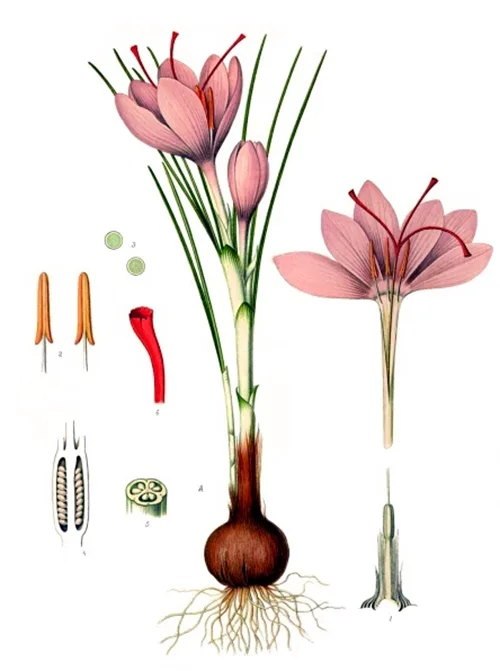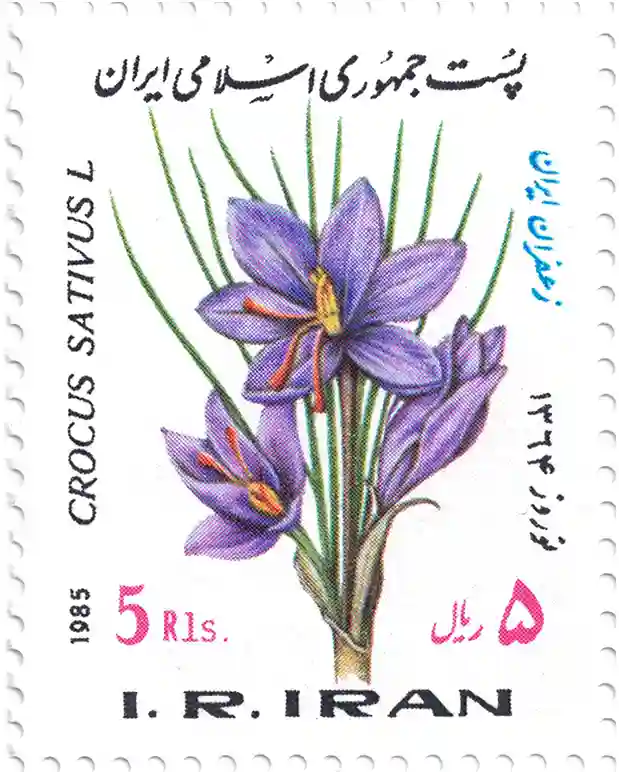Saffron in general
Saffron is the name of the spice obtained from the Crocus sativus Linnaeus. This crocus species, belonging to the family Iridaceae, is also known as the saffron crocus and is commonly referred to as saffron bulbs or saffron corms. It is the three bright red stigmas (stamens) of the flower that are dried and used for medicinal, flavor-enhancing, and pigmentation purposes.
Crocus sativus Linnaeus
 Carl Linnaeus was a Swedish botanist who lived in the 18th century and is considered the founder of modern taxonomy. He is best known for his system of classifying plants and animals based on their morphology and characteristics, known as binomial nomenclature.
Carl Linnaeus was a Swedish botanist who lived in the 18th century and is considered the founder of modern taxonomy. He is best known for his system of classifying plants and animals based on their morphology and characteristics, known as binomial nomenclature.
Linnaeus also played an important role in the classification of the saffron crocus, the plant from which saffron is obtained. He classified this plant as part of the family Iridaceae and gave it the scientific name Crocus sativus, which is still the official name to this day.
The word "sativus" comes from the Latin word "satus," which means "sown" or "planted." In botanical nomenclature, "sativus" is used to indicate that a particular plant species is grown or cultivated by humans, as opposed to wild-growing plants.
In the case of Crocus sativus, the word "sativus" is used because this crocus species is specifically cultivated for the saffron that is extracted from the stigma of the flowers. Therefore, the term "sativus" indicates that this is a cultivated plant species, rather than a wild-growing one. In tribute to Carl Linnaeus, who developed binomial nomenclature and is considered the father of modern taxonomy, "Linnaeus" is sometimes added to the scientific name making: "Crocus sativus Linnaeus."
Crocus sativus L. is a perennial bulbous plant that sprouts from a bulb-shaped corm. This autumn-blooming crocus is a sterile triploid plant and can only reproduce through its corms. Crocus sativus, therefore, does not form seeds. The saffron crocus has grassy, narrow green leaves and fragrant, lavender-colored flowers with purple veins. The flowers have 3 yellow stamens and three precious, extra-long (25-30 mm), vivid red stigmas that extend over the petals.
These three stigmas in the flowers of this crocus form the saffron. The stigmas are dried and used for medicinal, flavor-enhancing, and pigmentation purposes. As a flavor and colorant for food, these dried stigmas or threads are commonly known as saffron spice, which is said to be the most expensive spice in the world. Due to the labor-intensive production and the fact that so many flowers are needed to produce a small amount of saffron, the price of saffron is high.
Real quality saffron
Saffron spice gives a quaint bittersweet aroma, like honey and hay. It tastes as bittersweet as it smells. One has to taste it in order to know exactly how it tastes. Some say, “it’s mushroomy, and smoky.” Some say, “it does taste like the sea.” And some say, “it’s metallic, with honey tones and a whiff of seashells.” To know exactly how it tastes, you should try it for yourself.
More about saffron
On our website we tell you more about this extraordinary and special spice that has been cultivated for more than 4000 years and has many applications. You can find more information about the history of saffron and its various uses in the past and present.
We also tell you more about the cultivation of saffron and how you can set up your own saffron farm.

FAQs:
What is saffron?
Saffron is a spice derived from the Crocus sativus Linnaeus, also known as the saffron crocus. It is the three bright red stigmas (stamens) of the flower that are dried and used for medicinal, flavor-enhancing, and pigmentation purposes.
Why is saffron so expensive?
Due to the labor-intensive production and the fact that so many flowers are needed to produce a small amount of saffron, the price of saffron is high. It is therefore the most expensive spice in the world.
What does saffron taste like?
Saffron has a specific bitter-sweet aroma, similar to that of honey and hay combined. The taste is just as bitter-sweet as it smells. To know exactly how it tastes, you should try it for yourself.
What is saffron used for?
Saffron is used as a flavor and color enhancer for food, as a dietary supplement, as medicine, and for pigmentation. It is often used in the kitchens of the Middle East, India, Spain, and Italy.
Can I grow saffron myself?
Yes, it is possible to grow saffron yourself. It is relatively easy, but some knowledge and experience come in handy. On our website, you can find more information about saffron cultivation and how to start your own saffron farm.






















 BIO bulbs
BIO bulbs
 NON-BIO bulbs
NON-BIO bulbs
 Wholesale
Wholesale
 Miscellaneous flower bulbs
Miscellaneous flower bulbs

